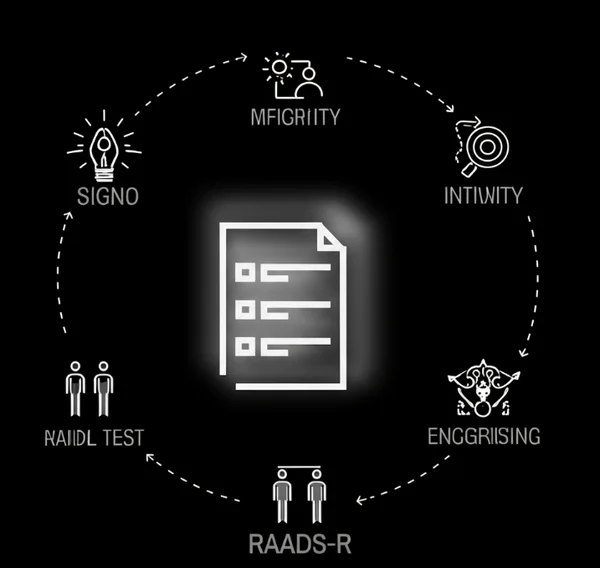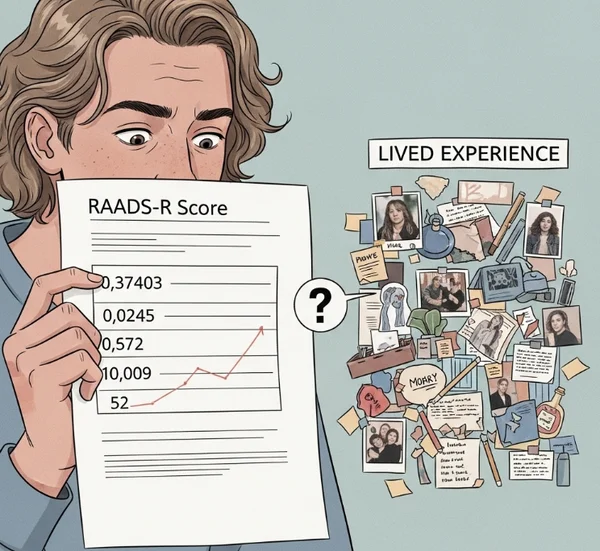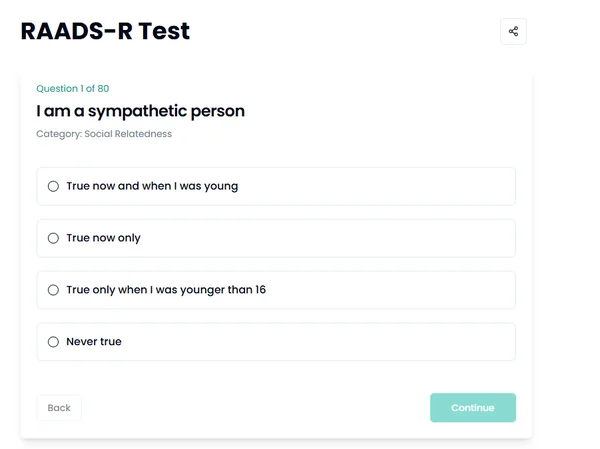RAADS-R Limitations & Autism Test Alternatives: A Guide
The RAADS-R test, available on raads-r.net, is a widely used self-assessment tool that many adults find helpful as a first step in exploring potential autistic traits. However, like any screening instrument, it's crucial to understand its scope and inherent RAADS-R test limitations. What are the limitations of the raads-r test? This article aims to transparently discuss these aspects, address common questions about RAADS-R test accuracy, and explore various autism test alternatives and complementary approaches for a more comprehensive autism evaluation. Our goal is to empower you with information so you can make informed decisions on your journey of self-understanding.
Understanding the Inherent Limitations of the RAADS-R Test
While the RAADS-R is a valuable resource, acknowledging its autism screening limitations is key to using it responsibly. Understanding "what if my raads-r score doesn't feel right?" often starts here.
The Nature of Self-Report: Subjectivity and Potential Bias
One of the primary limitations of the RAADS-R, like all self-report questionnaires, is its reliance on individual perception and memory. This introduces elements of subjectivity and potential self-report bias. How an individual interprets questions, their current emotional state, their level of self-awareness, or even a desire to see a particular outcome can influence responses. For instance, someone highly introspective might score differently than someone less aware of their internal states, even with similar underlying traits. This subjectivity is an important factor to consider.
Not a Diagnostic Tool: Why RAADS-R Cannot Confirm Autism
It cannot be overstated: the RAADS-R test is not a diagnostic tool. It is designed to screen for traits that may be indicative of autism. A high score suggests that further investigation is warranted, but it does not, by itself, confirm an adult autism diagnosis. Is raads-r test enough for diagnosis? The answer is a definitive no. Confirming autism requires a multifaceted clinical assessment by a qualified professional.
Sensitivity and Specificity: What RAADS-R Accuracy Really Means
When discussing RAADS-R test accuracy, terms like "sensitivity" (ability to correctly identify those with the condition) and "specificity" (ability to correctly identify those without the condition) are often used, based on research studies. While the RAADS-R has shown good psychometric properties in certain populations, its accuracy in a real-world, individual context can vary. These statistics apply to group averages in research settings and don't guarantee perfect accuracy for every individual.
Considerations for Specific Populations (e.g., Masking, Co-occurring Conditions, Cultural Factors)
The RAADS-R's effectiveness can also be influenced by individual differences and contexts:
-
Masking/Camouflaging Autistic Traits: Adults, particularly women or those diagnosed later in life, may have developed sophisticated strategies to "mask" or camouflage their autistic traits to fit in socially. This masking can lead to underreporting of traits on a self-assessment like the RAADS-R, potentially resulting in a lower score than their internal experience might suggest.
-
Co-occurring Conditions: As discussed in our other articles, conditions like ADHD, anxiety, depression, or personality disorders can have overlapping symptoms with autism. These co-occurring conditions can complicate self-reporting and potentially inflate or obscure scores related to core autistic traits.
-
Cultural and Gender Differences: The expression and perception of autistic traits can be influenced by cultural factors and gender differences in autism. The RAADS-R, like many tools, was developed within specific cultural contexts, and its applicability or interpretation might need careful consideration across diverse backgrounds.

When Your RAADS-R Score Feels Unclear or Incomplete
It's not uncommon for individuals to complete the RAADS-R test and find their score doesn't quite align with their internal sense of self or their lived experiences. What if my raads-r score doesn't feel right?
Interpreting Ambiguous Results: Beyond a Simple Number
An ambiguous RAADS-R score – perhaps one that falls in a borderline range, or a high score that still leaves you with questions – underscores why the test is just one piece of information. Numbers alone rarely capture the complexity of human experience. Instead of fixating solely on the score, consider it a prompt for deeper reflection. Our AI Personalized Analysis on raads-r.net can offer more nuanced insights beyond the raw score.
The Importance of Lived Experience Alongside Test Scores
Your lived experience is an invaluable source of information. If the RAADS-R score doesn't resonate, but you consistently identify with autistic experiences described by autistic individuals or in reputable literature, that self-awareness is significant. Test scores should complement, not invalidate, your personal understanding, especially when considering the subjectivity of self-report measures.

Exploring Autism Assessment Alternatives & Complements to RAADS-R
If the RAADS-R leaves you seeking more, or if you're looking for pathways to a formal diagnosis, several autism test alternatives and complementary methods are available. What other tools assess adult autism?
Clinical Interviews: The Cornerstone of Adult Autism Diagnosis
A thorough clinical interview conducted by a psychologist, psychiatrist, or other qualified professional specializing in autism is often considered the cornerstone of an adult autism diagnosis. This involves a detailed discussion of:
- Your developmental history (early childhood through adulthood).
- Current and past social communication and interaction patterns.
- Restricted and repetitive behaviors, interests, and activities.
- Sensory sensitivities and experiences.
- How these traits impact your daily functioning. This interview allows for nuanced exploration and clarification that a standardized questionnaire cannot achieve.
Observational Assessments: Tools Like the ADOS-2
For some adults, especially if self-report is challenging or if more objective behavioral data is needed, observational assessments like the ADOS-2 (Autism Diagnostic Observation Schedule, 2nd Edition) might be used. This involves structured and semi-structured activities designed to elicit social and communicative behaviors relevant to autism. While more commonly used with children, adapted modules exist for adolescents and adults.
Other Self-Report Questionnaires (e.g., AQ Test, CAT-Q, Aspie Quiz)
Other self-report questionnaires can offer different perspectives or focus on specific aspects:
- AQ Test (Autism-Spectrum Quotient): A shorter, widely used screener for autistic traits.
- CAT-Q (Camouflaging Autistic Traits Questionnaire): Specifically measures the extent to which individuals mask or camouflage their autistic traits. This can be very insightful alongside a tool like the RAADS-R.
- Various other online quizzes like the "Aspie Quiz" exist, but their validity and reliability vary greatly, so they should be approached with more caution than standardized tools.
Neuropsychological Testing: Assessing Cognitive Profiles
In some cases, a broader neuropsychological testing battery may be recommended. This can assess various cognitive functions, such as executive functioning, attention, language processing, and visual-spatial skills. While not diagnostic for autism on its own, it can help identify co-occurring conditions (like ADHD or learning disabilities) and provide a more comprehensive understanding of an individual's cognitive strengths and challenges, which is vital for a comprehensive autism evaluation.

Moving Towards a Comprehensive Autism Evaluation for Adults
If you're considering a formal diagnosis, understanding what a comprehensive autism evaluation for adults entails is important. How to get a full autism diagnosis after raads-r?
What to Expect from a Full Diagnostic Process
A full diagnostic process is typically multifaceted and may include:
- Initial Consultation/Intake: Discussing your concerns and history.
- Clinical Interview(s): Detailed exploration of developmental, social, communicative, and behavioral history.
- Standardized Questionnaires: May include the RAADS-R, AQ, or others, often for both the individual and sometimes a family member or partner (with consent).
- Observational Assessment (Optional): Such as the ADOS-2, if deemed necessary by the clinician.
- Review of Records: Any previous assessments or relevant medical/school records.
- Differential Diagnosis: Ruling out or identifying co-occurring conditions.
- Feedback Session: Discussing the findings, diagnosis (if any), and recommendations.
Finding Qualified Professionals for Adult Autism Diagnosis
Finding qualified professionals experienced in adult autism diagnosis can sometimes be challenging but is crucial. Look for clinical psychologists, neuropsychologists, or psychiatrists with specific expertise in assessing autism in adults. Resources like autism advocacy organizations (e.g., Autism Speaks, or local/national societies) may provide directories or guidance. You can also ask your primary care physician for a referral.
The Role of the RAADS-R Test in Informing Professional Assessment
Even with its limitations, the results from your RAADS-R test, which you can take on raads-r.net, can be a valuable piece of information to bring to a professional consultation. It can help articulate your concerns, provide a structured summary of your experiences, and serve as a starting point for discussion with the clinician.

Why Understanding RAADS-R Limitations Matters for Your Journey
Being aware of RAADS-R test limitations is not about diminishing its value, but about using it wisely.
Avoiding Misinterpretation and Self-Diagnosis Pitfalls
Understanding that the RAADS-R is a screening tool helps in avoiding misinterpretation of scores and the potential pitfalls of self-diagnosis. A score is an indicator, not a label. Is the raads-r test always accurate for everyone in every situation? No single screener can be.
Empowering Yourself with Accurate Information for Next Steps
Knowing the limits of any tool, including the RAADS-R, empowers you to seek accurate information and make informed decisions about your next steps, whether that's further self-exploration, seeking community, or pursuing a formal comprehensive autism evaluation. This knowledge helps you move beyond RAADS-R in a constructive way.

RAADS-R: A Valuable Step, But Part of a Bigger Picture
The RAADS-R test offers a valuable and accessible way for adults to begin exploring potential autistic traits. However, understanding its limitations is as important as understanding its strengths. It's a significant first step on a journey of self-awareness, but often part of a much bigger picture that may include other autism test alternatives and, crucially, professional insight for a comprehensive autism evaluation. Use the RAADS-R as a guide, a prompter for reflection, and a tool to help you articulate your experiences, but always remember its place within the broader landscape of autism assessment.
What are your thoughts on the limitations of self-assessment tools? Have you explored other avenues for understanding your neurodivergence? Share your insights and questions in the comments below!
RAADS-R Test Limitations and Next Steps
-
What are the main limitations of using only the RAADS-R test?
The main RAADS-R test limitations include its nature as a self-report tool (subject to bias and self-awareness levels), its inability to provide a formal diagnosis, and potential variations in RAADS-R test accuracy across different individuals, especially those who mask heavily or have significant co-occurring conditions.
-
How accurate is the RAADS-R test if I also have anxiety or depression?
Co-occurring conditions like anxiety or depression can influence how an individual responds to RAADS-R questions, potentially affecting the score. For example, social anxiety might lead to answers similar to those reflecting autistic social challenges. This is why a comprehensive autism evaluation by a professional is important to differentiate between conditions.
-
If my RAADS-R score is low but I still suspect autism, what should I do?
A low RAADS-R score doesn't necessarily rule out autism, especially if you heavily mask or if your traits present atypically. Trust your lived experience. Consider exploring other autism assessment alternatives like the CAT-Q (for camouflaging), journaling your experiences, and discussing your persistent concerns with a professional experienced in adult autism diagnosis.
-
Are there better or more definitive online autism tests than the RAADS-R?
No online self-report test, including the RAADS-R, can be "definitive" for diagnosis. Some tools may focus on different aspects (e.g., AQ for broader traits, CAT-Q for masking). The "best" initial tool depends on your specific questions. The RAADS-R is comprehensive for adult self-screening, but the most definitive assessment is always a comprehensive autism evaluation by a clinician. To start your exploration, try the RAADS-R test on our site.
-
What kind of professional should I see for a comprehensive autism evaluation after the RAADS-R?
You should seek a clinical psychologist, neuropsychologist, or psychiatrist who has specific experience and training in diagnosing autism spectrum disorder in adults. They can conduct the necessary clinical interviews, administer appropriate observational assessments if needed, and consider all factors for an accurate adult autism diagnosis. Your RAADS-R results from raads-r.net can be a helpful starting point for that conversation.